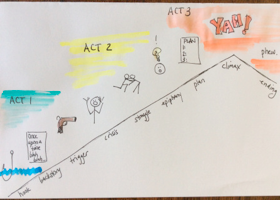Donna Tartt’s, The Goldfinch, hijacked my social life for the past two weeks. And consequently, my life as a binge reader emerged once again.
For months, I can exist perfectly content on my diet of short stories. Then, the unwieldy novel finds me unsatisfied in my 5000 word count stories, lures me to a world of plots with multiple characters and offers a new captivating world to enjoy and forget the everyday mundane. The process begins innocently enough — an evening hour in a big chair with my feet up, a chapter instead of dinner, an alarm set earlier to read before breakfast, and eventually the pages of a 784 page tome reluctantly parted across my sleeping self — until in the middle of the night, the book falls, thudding loudly against the floor, startling the dog who barks and wakes the household and next door neighbors.
How does this happen to me? I confess a predilection for Donna Tartt’s brand of storytelling. Is Tartt’s magic the plot or the theme? A diagram from the NY Book Editors shows themes of prize winning novels in 2014. The Goldfinch won the 2014 Pulitzer Prize and contains many of the plot lines of prize-winning novels: unlikely friendships, betrayal, terrorism, death, theft, school days, running away, criminal gangs, love and suicide. Other winning plots include less appealing topics: cannibalism, East London, homicidal cowboy brothers, an escaped tiger, horniness, jazz, nanny trust issues, a mysterious letter, Totalitarian Bucharest, and war. As to plot, Tartt chose well except I am intrigued by the cowboy idea.
 The NY Book Editors post also includes speculation on what makes an interesting story. The answer is a good story arc. Larry Brooks’ Story Engineering also covers these topics along with a bevy of books about story structure. In “Writing Fiction Like a Pro” by Steve Alcorn, the classic three act structure includes nine dramatic elements. For the elements, I included a sketch by fellow writer and classmate, Mame Zirro.
The NY Book Editors post also includes speculation on what makes an interesting story. The answer is a good story arc. Larry Brooks’ Story Engineering also covers these topics along with a bevy of books about story structure. In “Writing Fiction Like a Pro” by Steve Alcorn, the classic three act structure includes nine dramatic elements. For the elements, I included a sketch by fellow writer and classmate, Mame Zirro.
Act 1 introduces the characters, the setting and the story. Through The Goldfinch’s adolescent narrator, Theo, the reader meets his mother and learns the critical backstory. The trigger is the plot point that propels the protagonist into Act 2. It is also called the inciting incident or the door that the character passes through that cannot be undone. Theo’s plot point occurs after the museum explosion. Surrounded by debris, Theo meets Welty and follows his advice. With his mother missing and his theft of a famous masterpiece, he cannot go back to his former life.
Act 2 is the middle of the story. Our boy, Theo, is in crisis – dead mother, abandoned by his father, nowhere to go, no one to turn to, stolen painting, and dead man’s ring. Imagine a horizontal graph of time. After the beginning first act, the middle second act extends for the bulk of the novel. In the case of The Goldfinch, Act 2 is 400-500 pages of Theo’s escalating struggles with his friend’s family, his father’s return, his misadventures in Las Vegas and his betrayal of father-figure Hobart.
Act 2 ends with another plot point. This time the story veers in an unexpected direction. Act 3 is the shortest in duration and the highest point of tension. While Act 2 concentrated on the emotional story and struggles of the protagonist, Act 3 is all plot. Theo is older and burdened by his theft and loss of the famous Fabritius painting of The Goldfinch. His epiphany guides him to a new course of action, a solution for the greater good and his final plan to save the painting, actually several plans, since nothing in a Tartt novel will work the first time. The climax ends where the story began in Amsterdam. I will leave the ending untold for future readers to enjoy. Suffice it to say, Act 3 resolves Theo’s many problems.
The three act structure probably has as many critics as Donna Tartt. Some argue for more than three acts and others for less, such as the simplicity of creating a problem and resolving a problem. The internet displays diagrams of pinch points and new takes on structure with grids, circles and even circus tents. As for Donna Tartt, even the literary crowd disagrees on whether this is a fabulous adult novel or a Harry Potter-esque children’s book. Reviews on Goodreads offer accounts of unfinished readings (no doubt from quitters, wimps and lightweights) in contrast to exhilarating comments about the plot and characters.
For this novel with a massive three act structure, my vote is yes. Read it. But don’t drop it on your foot. Don’t try to fit it in your backpack or purse. And don’t drop it in the middle of the night unless you want to risk a call to 911 from the neighbors.


